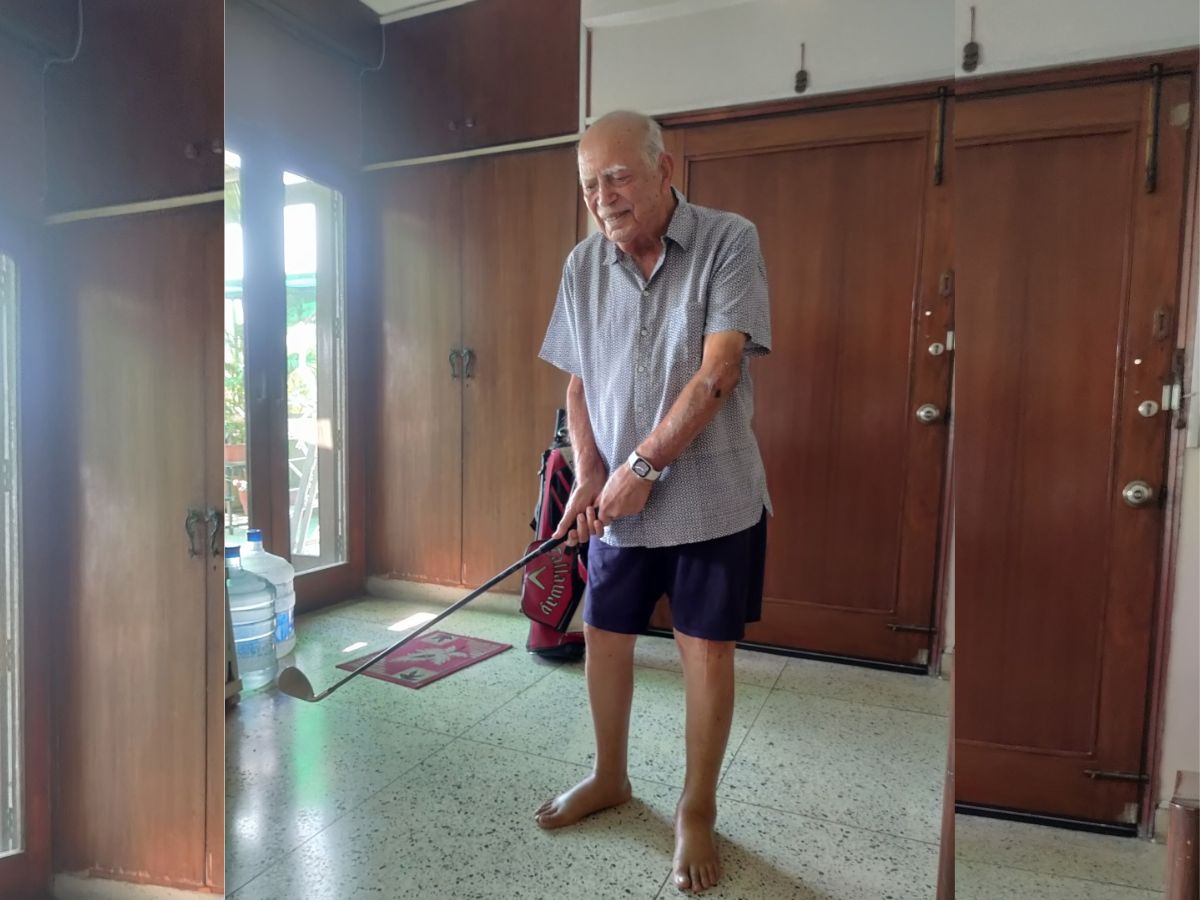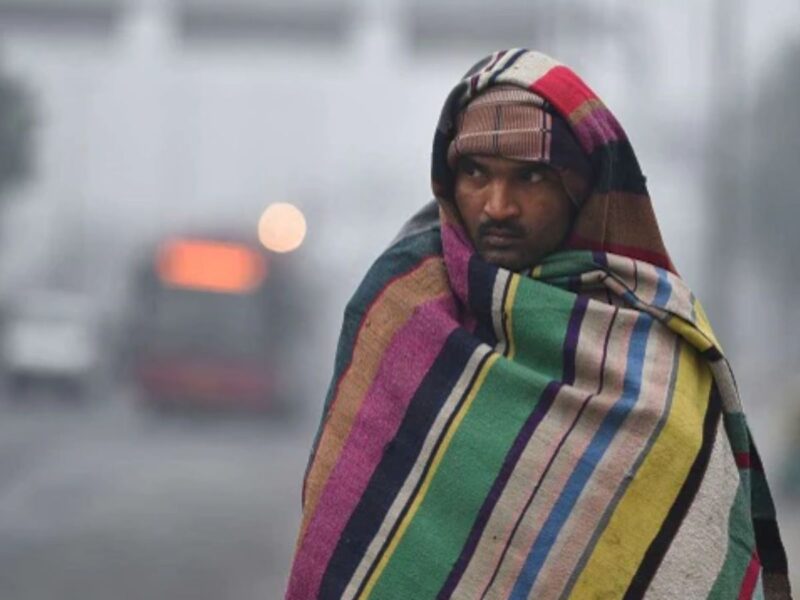Octogenarian Prakash Bhandari, Delhi’s first-ever Test cricketer, betrays the enthusiasm of a youngster while preparing to leave his home for a bridge tournament.
There is a set of golf clubs in a bag by the side of the entrance, which hasn’t been used for the last couple of months due to the 88-year-old experiencing swelling and pain in his legs.
But his love for sport remains undiminished as he looks forward to the game of bridge after lunch.
Post cricket, he picked golf and bridge and alternates between the two winning multiple tournaments in the latter.
Rarely does he talk cricket unless asked to do so. He has left the sport and its memories far behind.
Cricket touched his life after his grandfather sold off their home at Barakhamba Road in 1944 and moved a few kilometres away to Rohtak Road, Karol Bagh, where while studying at Khalsa School, he once encountered a group of boys playing cricket.
“There were school-boys practicing. Someone hit a high shot and I caught it. That is how I got hooked to cricket and joined a local club,” recalls Bhandari.
That was the time India was coming out of the Raj era, an age without cricket grounds or easily accessible equipment let alone academies for common people. The emergence of cricket in a mohalla more often than not depended on an initiative taken by cricket enthusiasts in the neighbourhood.
Dr Rampal was that enthusiast in Bhandari’s neighbourhood. He ran a medical clinic under a shed and also invited his patients to play cricket.
“At the age of 13-14, I started going to Friends Club, which used to be run by Dr Rampal and his buddies on a small plot of land nearby. They practiced on matting pitch. There must have been 20-25 cricket clubs at the most in Delhi back then; there were some in Daryaganj.”
Dr Rampal’s box had two bats, not of compressed wood as is the case nowadays but those with parchment, as well as the remaining equipment which the team shared.
It was only after joining Ramjas School that he began getting opportunity to get into the cricket system through inter-school competition.
But it was his admission in 1952 to Hindu College, then at Kashmere Gate, which got him into serious cricket. He’d often cycle down to the college from his home.
Back then, Delhi and District Cricket Association (DDCA) was a small body, comprising “30-35-year-old people who used to work in Central Secretariat”.
“Then Lala Amarnath (former India captain and country’s first-ever Test centurion who lived in Delhi but never played for them) tried to break that. He invited college kids — Bobo, Lekhraj, YM Chaudhary, Rajan Mehra, all university players, to practice with him at the Ferozeshah Kotla. I was one of them,” recalls Bhandari.
Lala, an All-India selector then, took a liking to young Bhandari when he saw him delivering his off-spin bowling.
“He used to have nets with the boys and used to bat and bowl. I was doing some off-spin bowling then and he was very impressed. Then he catapulted me into the North Zone team for the tour game against Pakistan in Amritsar even though I hadn’t yet played for Delhi or any other team.”
The Pakistan team had arrived in October for the match and since the first-class season hadn’t begun, there was no time to field Bhandari in a first-class game and trial him.
“I was included due to Lala’s pull.”
That Pakistan team included Hanif Mohammad, himself a teenager, but one spoken of very highly due to his watertight defence and great technique. Before Sunil Gavaskar had set foot on a cricket pitch, Hanif was the ‘Little Master’, the original one.
It must then have been a special delivery from Bhandari, just about a year younger to Hanif, which managed to beat Hanif’s defence.
“I took five wickets. Hanif scored a century. The off-spin, with which I bowled Hanif, was my ball of the century. It floated out and then spun back in. He was totally surprised to seem himself bowled. His defence was solid and he had already scored a 100,” reminisces Bhandari.
Bhandari had to wait for next year to play Test, unofficial though, when the SJOC (Silver Jubilee Overseas Cricket Team) arrived in India.
He was called for trials at the Cricket Club of India (CCI) as the India team to tour Pakistan was being picked.
He scored an 80-odd and was selected.
“I went to Pakistan and played in the fifth and last Test. I was played as the 12th man in all the four Tests because of my fielding skills.”
In the fifth Test, on a “bouncy track in Karachi made by host Pakistan to force a win”, Bhandari was India’s second highest-scorer in first innings with just 19 at No. 8.
Surprisingly, he wasn’t given a single ball to bowl by captain Vinoo Mankad.
“Polly [Umrigar] kept bowling [his off-spin in second innings].”
This was despite Indians struggling to get wickets in second innings after low scores by both sides in the first turn.
Bhandari played two more Tests, one on a flat surface against New Zealand in Delhi, which produced just 10 wickets from both sides over five days – Bhandari batting at No. 8 and getting just 13 of the 234 overs bowled to the Kiwis — and then against Australia in Kolkata, where again the then captain Umrigar didn’t give him an over to bowl.
Back then, cricket didn’t pay much as “we got just 50 rupees a day for a Test”.
So, getting a job was a priority for cricketers. The search of it made him shift to Calcutta (now Kolkata) in 1957, where he first worked for South-Eastern Railways, beating a Nari Contractor-led another Railways side in the final of a tournament. He then moved to Reckitt & Coleman, and then shifted to SK Birla’s set-up.
Russi Mody, himself a cricket enthusiast, took him to Tata Steel in 1961.
While in Calcutta, he played for the Bengal Ranji team.
There was, it seemed, now an opportunity to remind Mankad of talent.
“I was a Test cricketer and therefore, given the opportunity. Bengal reached semi-finals and went to Udaipur to play against Rajasthan which was led by Vinoo Mankad. Although we lost, I scored the fastest century there. That record stood for 27 years. The century was scored in 60 minutes. Nobody had achieved it in 60 minutes. I also took six wickets.”
Bhandari, suffering from asthma, gave up cricket even before turning 30 but then a chance to play the game arose again when he was visiting his mother and aunt in Delhi from Hyderabad, where he had shifted.
“Russi Mody posted me to Hyderabad in Tata Steel. Cricket was past me. I came back to Delhi on a holiday in 1967 to visit my aunt and mother, and Bishan Singh Bedi and Vijay Mehra all came to know that I am here. These guys were playing Ranji Trophy and asked me to play for Delhi since I wasn’t playing for any state,” adds Bhandari.
Why Bedi and Mehra were desperate to make him play for Delhi was evident from his performance in the match against Punjab.
“I scored a double century in just over two sessions. I had gone for a few balls just prior to lunch and by stumps I had scored a double. My name was everywhere. Then we went on to beat Punjab and won the North Zone.”
Mody shifted him to Jamshedpur and Dhanbad, where he picked up golf and also represented Bihar in Ranji Trophy. But soon cricket came to a complete halt.
That was the start of his second innings, built on golf and bridge.
“I never wanted to get involved in Delhi and District Cricket Association (DDCA). That was murky water. I had already taken Delhi Golf Club (DGC) membership in 1971.”
Membership to DGC wasn’t full and was available then unlike now, when the waiting period can extend to over a decade.
He played golf, bettering some top players and it was in 1984, a year before he finally returned to Delhi, when he started serving as international rules official in golf. He served as that for 13 years (1985 to 1997), at the prestigious US Masters at Augusta, one of the four Majors.
Then in 2003, he and others began the Delhi Golf Society to promote golf in Delhi.
“My working career got over in 2010 or so. After that I have been devoting time for promotion of golf. I have no other job.”
Bridge too. And it is a coincidence that the club he plays Bridge for nowadays in Delhi’s Friends Colony, is called Friends Club, just like his first cricket club was called some 75 years ago.





